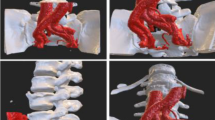Abstract
Study Design
Retrospectively reviewed surgeries between 2011 and 2015 of patients who underwent posterior spinal deformity instrumentation with constructs involving fusions to pelvis and encompassing at least five levels.
Objective
Measure the radiographic outcomes of coronal malalignment (CM) after use of an intraoperative T square shaped instrument in posterior spinal deformity surgeries with at least five levels of fusion and extension to pelvis.
Background
Neuromuscular children found to benefit from intraoperative T square technique to help achieve proper coronal spinal balance with extensive fusions. This intraoperative technique used in our posterior spine deformity instrumentation surgeries with the aforementioned parameters.
Methods
There were 50 patients: n = 16 with intraoperative T square and n = 34 no–T square shaped device. Subgroups divided based on greater than 20 mm displacement and greater than 40 mm displacement of the C7 plumb line to the central sacral vertical line on either side in preoperative radiographs. We analyzed the demographics and the pre- and postoperative radiographic parameters of standing films: standing CM (displacement of C7 plumb line to central sacral vertical line), and major coronal Cobb angles in total sample and subgroups and compared T square shaped device with no–T square shaped device use by analysis of variance. A p value ≤.05 is statistically significant.
Results
In the total sample, though postoperative CM mean was not statistically different, we observed greater CM corrections in patients where a T square shaped device was used (70%) versus no–T square shaped device used (18%). In >20 mm and >40 mm subgroups, the postoperative mean CM values were statistically lower for the patients where a T square shaped device was used, p = .016 and p = .003, respectively. Cobb corrections were statistically higher for T square shaped device use in both >20 mm and >40 mm subgroups, 68%, respectively.
Conclusion
The intraoperative T square shaped device technique had a positive effect on the amount of spine coronal malalignment correction after its use and for lumbar and thoracic coronal Cobb angles.
Level of Evidence
Level III.
Similar content being viewed by others
References
Stokes IA. Three-dimensional terminology of spinal deformity. A report presented to the Scoliosis Research Society by the Scoliosis Research Society Working Group on 3-D terminology of spinal deformity. Spine (Phila Pa 1976) 1994;19:236–48.
Andras L, Yamaguchi Jr KT, Skaggs DL, et al. Surgical technique for balancing posterior spinal fusions to the pelvis using the T square of Tolo. J Pediatr Orthop 2012;32:e63–6.
Lehman Jr RA, Lenke LG, Helgeson MD, et al. Do intraoperative radiographs in scoliosis surgery reflect radiographic result? Clin Orthop Relat Res 2010;468:679–86.
Vidal C, Ilharreborde B, Queinnec S, et al. Role of intraoperative radiographs in the surgical treatment of adolescent idiopathic scoliosis. J Pediatr Orthop 2016;36:178–86.
Daubs MD, Lenke LG, Bridwell KH, et al. Does correction of preoperative coronal imbalance make a difference in outcomes of adult patients with deformity? Spine (Phila Pa 1976) 2013;38: 476–83.
Ploumis A, Liu H, Mehbod AA, et al. A correlation of radiographic and functional measurements in adult degenerative scoliosis. Spine (Phila Pa 1976) 2009;34:1581–4.
Glassman SD, Breven S, Bridwell K, et al. Correlation of radiographic parameters and clinical symptoms in adult scoliosis. Spine (Phila Pa 1976) 2005;30:682–8.
Ploumis A, Simpson AK, Cha TD, et al. Coronal spinal balance in adult spine deformity patients with long spinal fusions: a minimum 2- to 5-year follow-up study. J Spinal Disord Tech 2015;28: 341–7.
Miller DJ, Jameel O, Matsumoto H, et al. Stud Health Technol Inform 2010;158:141–6.
Author information
Authors and Affiliations
Corresponding author
Additional information
Author disclosures: SK (none); UM (none); HY (none); RAT (personal fees from Styker Spine and Vertiflex, outside the submitted work); WFL (grants from DePuy, Medtronic, IntegraLife, Sigmus, Inc., Spinal Kinetics, Inc., K2M, Inc., Providence Technologies, Stryker Spine, and Vertebral Technologies, Inc., outside the submitted work).
Rights and permissions
About this article
Cite this article
Kurra, S., Metkar, U., Yirenkyi, H. et al. Assessment of Coronal Spinal Alignment for Adult Spine Deformity Cases After Intraoperative T Square Shaped Use. Spine Deform 6, 267–272 (2018). https://doi.org/10.1016/j.jspd.2017.10.012
Received:
Accepted:
Published:
Issue Date:
DOI: https://doi.org/10.1016/j.jspd.2017.10.012




